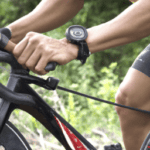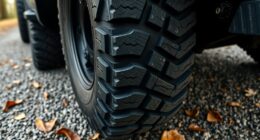To optimize your time trials, focus on controlling your breathing and maintaining a steady cadence. Breathe deeply through your nose, aligning your breath with your pedal stroke for efficiency and relaxation. Aim for a cadence around 85-95 rpm, adjusting based on your effort and fatigue signals. Keeping both consistent helps conserve energy and improve endurance. If you keep practicing these techniques, you’ll discover how to sustain effort and improve your overall performance seamlessly.
Key Takeaways
- Synchronize deep, diaphragmatic breathing with pedal strokes to enhance oxygen efficiency and promote relaxation during TTs.
- Maintain a steady cadence, typically 85-95 rpm, to optimize power output and reduce muscular fatigue.
- Use real-time cadence feedback to adjust and sustain an ideal pedaling rhythm throughout the effort.
- Focus on nasal breathing and full lung expansion to increase lung capacity and prevent hyperventilation.
- Practice deliberate cadence and breathing calibration during training for consistent, efficient pacing in time trials.

When it comes to time trials, mastering your breathing and cadence can make a significant difference in your performance. These elements are fundamental to maintaining efficiency and stamina during your ride. Breathing techniques aren’t just about inhaling and exhaling; they’re about controlling your airflow to maximize oxygen delivery while minimizing fatigue. Proper breathing helps you sustain a steady rhythm and avoid unnecessary energy drain. Focus on deep, diaphragmatic breaths that fill your lungs fully, allowing for better oxygen exchange. Practice nasal breathing when possible, as it promotes a calmer, more controlled respiration pattern, especially during steady-state efforts. As you settle into your TT, avoid shallow, rapid breathing, which can lead to hyperventilation and increased fatigue. Instead, aim for a rhythm that matches your pedaling cadence, fostering a smooth, integrated effort. To enhance your breathing efficiency, consider incorporating calibration techniques that help you find your optimal respiratory pattern.
Cadence optimization is equally critical. Your cadence—the number of pedal revolutions per minute—directly influences your efficiency and muscular fatigue. Finding your ideal cadence involves balancing power output with sustainability. Too high, and you risk early exhaustion; too low, and you might be inefficient, wasting energy with each pedal stroke. During a time trial, maintaining a consistent cadence helps your body settle into a steady rhythm, conserving energy for the duration of the effort. Many riders find that a slightly higher cadence, around 85 to 95 rpm, tends to reduce muscular strain, but this varies based on your physiology and riding style. To refine your cadence, practice deliberate shifts during training to discover what feels most natural and sustainable at different power levels. Use a cadence sensor or bike computer to monitor your pace and make real-time adjustments if you notice fluctuations.
Integrating breathing techniques with cadence refinement creates a harmonious rhythm that enhances your overall performance. For example, syncing your breath with your pedal stroke can improve efficiency and help you stay relaxed under pressure. When your breathing is aligned with your cadence, you reduce the risk of overexertion and maintain a steady supply of oxygen to your muscles. During a time trial, focus on maintaining this rhythm consistently, especially during climbs or when facing headwinds. Developing these habits through regular training ensures they become second nature when it counts most. Remember, the goal isn’t just to go fast but to do so sustainably. Fine-tuning your breathing and cadence allows you to push your limits without burning out prematurely, making every second on the clock count.
Frequently Asked Questions
How Does Breathing Affect Overall Time Trial Performance?
Your breathing depth directly impacts your overall time trial performance by helping you maintain mental focus and manage fatigue. When you breathe deeply, you guarantee your muscles get enough oxygen, which boosts endurance and efficiency. Good breathing habits also keep your mind clear during high-pressure moments, preventing mental fatigue. By controlling your breath and maintaining steady cadence, you optimize your performance, helping you finish strong and achieve your best time.
What Is the Ideal Cadence for Different Rider Heights?
Your ideal cadence varies with height, gear selection, and aerodynamic positioning. Taller riders often benefit from a slightly lower cadence to maximize power without sacrificing efficiency, while shorter riders may prefer a higher cadence for better control. Focus on maintaining a smooth, consistent pedal stroke in your chosen gear and aerodynamic position. Adjust your cadence based on comfort and performance, ensuring you’re neither overexerting nor underchallenging yourself during the time trial.
How Can I Improve My Breathing Efficiency During a TT?
Imagine you’re racing against a friend, and you notice they breathe more efficiently. To improve your breathing, focus on breathing techniques like diaphragmatic breathing, which increases oxygen intake and reduces fatigue. Practice steady, deep inhales through your nose and controlled exhales. Incorporate these techniques during training, and you’ll notice better oxygen intake, enhanced endurance, and more effective energy use, helping you maintain ideal power throughout your TT.
Should Breathing Patterns Change During Various Race Phases?
Yes, your breathing patterns should change during different race phases. During steady-state efforts, focus on breath control and maintaining a consistent cadence synchronization to maximize oxygen intake and efficiency. As you approach a climb or sprint, you might need to breathe more rapidly or deeply to meet increased demand. Adapting your breathing ensures you stay energized and maintain peak performance throughout the race.
How Does Cadence Influence Muscle Fatigue in TTS?
Imagine your cadence as the steady drumbeat guiding your race. When you maintain an ideal cadence, you promote muscle endurance and help manage fatigue effectively. A higher cadence reduces strain on muscles, preventing early fatigue, while a lower cadence may cause overexertion. By fine-tuning your cadence, you keep your muscles resilient, enabling sustained power and better fatigue management throughout the time trial.
Conclusion
Mastering your breathing and cadence isn’t just about rhythm; it’s about control in chaos. Like finding calm in a storm, the right breath and pace turn a simple run into a powerful experience. When you focus on these elements, you’re not just moving forward—you’re transforming your race. So, embrace the quiet moments between strides, because in those pauses, you discover strength, resilience, and the true rhythm of your run.














